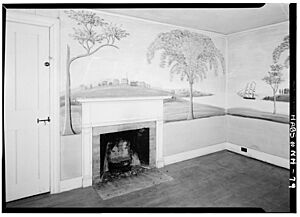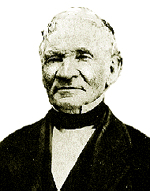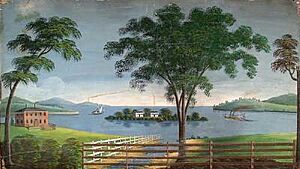Rufus Porter (inventor) facts for kids

Rufus M. Porter (born May 1, 1792 – died August 13, 1884) was an amazing American artist and inventor. He was also the person who started Scientific American magazine, which is still popular today!
Contents
Early Life and Family Connections
Rufus Porter came from a very old and important family in New England. His family first came to America from England in the early 1600s. They became very successful landowners.
Many of Rufus's relatives were important people. They included ministers, doctors, lawyers, and even a professor. He was also connected to famous people like the poet Henry Wadsworth Longfellow. Rufus's parents were Abigail and Tyler Porter.
Growing Up in New England
Rufus was born in West Boxford, Massachusetts. He was one of six children in his family. He started school when he was just four years old.
When Rufus was nine, his family sold their farm and moved to Maine. They lived in a place called Pleasant Mountain Gore, which is now part of Bridgton. At age 12, Rufus went to Fryeburg Academy for six months. Later, in 1807, he began learning to be a shoemaker.
Rufus Porter's Marriages and Children
In 1815, Rufus married Eunice Twombly from Portland, Maine. They had ten children together. Some of their children included Stephen, Rufus King, and Nancy.
Later, in 1849, Rufus married Emma Tallman Edgar. They had six more children. Sadly, most of these children died when they were babies. Only one, Rufus Frank Porter, lived to be an adult.
Rufus Porter's Artistic Journeys
By 1816, Rufus was living in New Haven, Connecticut. He even ran a dancing school there! This is also when he started painting portraits of people.
Rufus loved to travel. In 1818 and 1819, he went on a trading trip to the Pacific Northwest and Hawaii. After that, he returned to painting. He traveled all over, painting portraits in states like New York, New Jersey, Maryland, and Virginia.
Becoming a Mural Painter
Between 1825 and 1845, Rufus became a very busy mural painter. He decorated about 160 homes and inns! You can find his murals in Connecticut, Massachusetts, Maine, New Hampshire, Vermont, and even as far south as Virginia.
His murals were often very large. He painted them directly onto dry plaster walls. He used a mix of freehand painting and stencils. Sometimes he even used a cork stopper to stamp in leaves! He often painted portraits of the family members in the houses he decorated.
Rufus Porter: The Amazing Inventor
Rufus Porter was an incredibly creative person and a very active inventor throughout his life. People said he invented many things to make farm work easier.
He published books about interesting arts and experiments. He even built a special portable camera that helped him make quick silhouette portraits. He charged only 20 cents for these!
A Mind Full of Ideas
Rufus experimented with many different inventions. These included a wind-powered gristmill, a washing machine, and a corn sheller. He also worked on a fire alarm, a rope-making machine, and a camera.
He invented clocks, railway signals, and even a life preserver. He also created a revolving rifle. However, he often missed chances to make money from his inventions. For example, he sold the rights to his revolving rifle design to Samuel Colt for only $100.
Founding Scientific American Magazine
In 1841, Rufus bought part of a magazine called New York Mechanic. He published and edited it in New York. This magazine focused on industry, inventions, and scientific improvements.
After a while, Rufus moved the magazine to Boston and renamed it American Mechanic. He used this magazine to share his ideas for new inventions, like a special plow and a heating system. He also advertised his patent agency, which helped people get patents for their inventions.
The Birth of a Famous Magazine
In 1845, Rufus started a brand new weekly magazine called Scientific American. Just ten months later, he sold it to Orson Desaix Munn and Alfred Ely Beach.
The very first issue of Scientific American was published by Rufus Porter. It promised to show new inventions, scientific ideas, and interesting works. It also included news about mechanical and scientific improvements from America and other countries. The magazine was meant to help mechanics, manufacturers, and farmers. It also aimed to teach children and young people useful information.
Rufus was a very religious person. He often wrote about his beliefs in the articles he published.
Rufus Porter's Airship Dreams
In 1849, Rufus Porter had a big dream: to build a giant, steam-powered airship. He wanted it to be 800 feet long and carry 50 to 100 passengers. His goal was to fly miners to the California Gold Rush!
He had already built and flown smaller models of his airship in Boston and New York. He even advertised flights from New York to California, asking for a $50 down payment for a $200 ticket.
Challenges in the Sky
Rufus started building his first "aeroport," which was 240 feet long. But a tornado destroyed it! Later that year, he began building a 700-foot version with new supporters. However, during a showing, visitors accidentally tore the hydrogen bag, and it was destroyed again. In 1854, his third attempt also ran into technical problems.
Rufus Porter's Legacy
Rufus Porter passed away on August 13, 1884, at his son's home in West Haven, Connecticut. He was buried in Oak Grove Cemetery.
His obituary in Scientific American described his amazing and busy life. The magazine said that even though he wasn't as famous as other inventors like Morse or Edison, Rufus Porter would be remembered as a great example of American invention. He truly helped his fellow humans with his many ideas.
Writings by Rufus Porter
- 1825 A Select Collection of Valuable and Curious Arts, and Interesting Experiments
- 1849 Aerial Navigation: The Practicality of Traveling Pleasantly and Safely from New York to California in Three Days
Murals by Rufus Porter
- Birchwood Inn, Temple, New Hampshire
- Daniel Carr House, North Haverhill, New Hampshire
- Benjamin Cleaves House, Bridgton, Maine (Rufus Porter Museum)
- Eaton House, Bradford, New Hampshire
- Hancock Inn, Hancock, New Hampshire
- Kent House, Lyme, New Hampshire
- Prescott Homestead, Jaffrey, New Hampshire
- Reed Homestead, Townsend, Massachusetts
- Walter Russell House, Ashburnham, Massachusetts; part of the Cambridge Grant Historic District
- Mural House, Greene, Maine
- Damon Tavern, North Reading, Massachusetts





